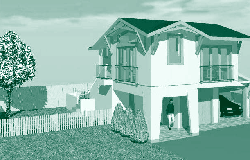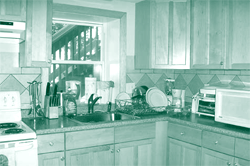March 2009
In this Issue
Regional Cooperation Reduces Homelessness in Virginia
A Response to Limited Space for Affordable Housing
Housing for Families Affected by HIV/AIDS
After the Storm: How Universities are Furthering Reconstruction
In the next issue of ResearchWorks
A Response to Limited Space for Affordable Housing
Built-out communities and jurisdictions with land use restrictions face significant barriers to implementing affordable housing. When confronted with a shortage of land suitable for development, community leaders must often come up with more creative solutions. Some jurisdictions are now turning to accessory dwelling units (ADUs) — also referred to as granny flats, accessory apartments, or second units — as a way of increasing the supply of affordable housing. A new report, Accessory Dwelling Units: Case Study, prepared for HUD's Office of Policy Development and Research, examines the history and benefits of ADUs and highlights six communities that have successfully implemented ADU ordinances.

Before the rise of suburbanization, ADUs were common in many single-family neighborhoods. The advent of Euclidean zoning codes encouraged the separation of land uses, which in turn led to prohibitions against ADU construction in many zoning districts across the country. In some instances, even preexisting units were deemed to be nonconforming. However, with the growing demand for affordable housing and the emergence of anti-sprawl and smart growth design movements (such as New Urbanism), ADUs are quickly regaining acceptance as a cost-effective means of increasing the affordable housing supply.
An Affordable Housing Option
ADUs are secondary living quarters located on single-family lots — complete with separate kitchen and bathroom facilities — but independent of the primary residence. Depending on their location, ADUs can be classified as interior, attached, or detached.
Communities implementing ADU ordinances to increase their affordable housing options are finding that ADUs offer several benefits. First, development costs of ADUs are significantly lower compared with those of new, single-family homes on separate lots. ADUs also do not require additional public infrastructure such as roads, sewers, and storm drainage.
Further cost savings can be achieved in the planning and approval processes, in that communities can meet the demand for housing without having to make zoning changes. ADUs can be designed to blend in with the surrounding architecture, thereby maintaining neighborhood compatibility and preserving community character. These units are convenient and affordable to elderly or disabled persons who may want to live close to family members and caregivers while maintaining a sense of privacy and independence. Empty nesters or first-time homebuyers can offset their mortgage payments by adding a second unit, and young adults newly entering the workforce benefit from the lower rents.
ADU Case Studies

The six case study communities highlighted in the report exhibit diverse geographic, demographic, and socioeconomic characteristics, and employ different land use and growth control policies. Towns such as Lexington and Wellfleet in Massachusetts are built-out communities with limited land available for new residential development, whereas Portland, Oregon and Fauquier County, Virginia have strong growth boundaries. Barnstable, Massachusetts had numerous illegal accessory units that needed to be brought into compliance, and the high-end, high-demand real estate market of Santa Cruz, California led to a steadily increasing need for affordable housing.
Each of the study areas adopted variations of bylaws and code revisions in order to allow ADUs to be built on single-family lots. Their regulations allow one to three ADUs per lot, with varying occupancy and development standards. To encourage participation in ADU programs, all of the study areas offer incentives, such as setback and parking requirement reductions, fee waivers, and administrative assistance. A few even offer financial assistance in the form of interest-free loans and property tax exemptions.
In exchange for providing incentives, most of the study areas impose affordability requirements on the accessory units. For example, the town of Wellfleet, Massachusetts offers tax exemptions to homeowners on the portion of the property that's rented as an affordable unit. Barnstable adopted an Amnesty Program in 2003 to bring existing illegal ADUs into compliance. Property owners participating in the program must rent the ADUs to low-income families earning no more than 80 percent of the area median income, with a minimum lease term of one year.
Revising restrictive zoning policies and adopting incentive programs to encourage ADU development has proven advantageous to the study areas. Santa Cruz, California has issued 40 to 50 permits annually since the start of its ADU program, while Barnstable has successfully converted existing illegal accessory apartments into code-compliant and affordable ADUs. By making efficient use of existing housing stock, Portland and Fauquier County have successfully increased the affordable housing supply within their respective growth boundaries.
These studies show that a community can tailor ADU programs to suit its specific goals and requirements. However, findings indicate that the most successful ADU programs are flexible and uncomplicated, offer fiscal incentives, and are supported by public education campaigns that increase awareness and generate community support.
Accessory Dwelling Units: Case Study is available as a free download at www.huduser.gov/publications/affhsg/adu.html or in print, free of charge, by calling HUD USER at 800.245.2691.

